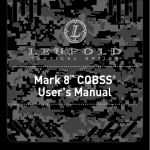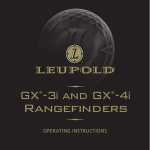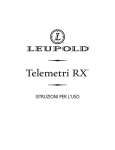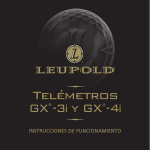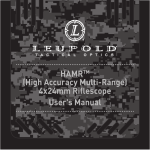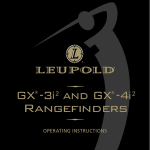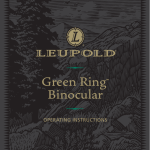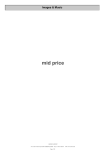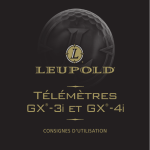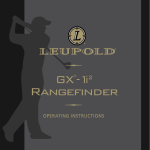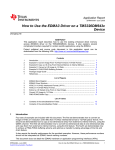Download Mark 8TM CQBSSTM User`s Manual
Transcript
Mark 8TM CQBSSTM User's Manual www.leupold.com Part# 111217 Artwork# 111216C Table of Contents Know Your Scope . . . . . . . . . . . . . . . . . . . . . . . . . . . . . . . . . . . . . . . . . . . . . . Page 2 How to Install the Scope . . . . . . . . . . . . . . . . . . . . . . . . . . . . . . . . . . . . . . . . Page 4 How to Sight-In . . . . . . . . . . . . . . . . . . . . . . . . . . . . . . . . . . . . . . . . . . . . . . . . Page 8 Making Precise Windage And Elevation Adjustments . . . . . . . . . . . . . . . Page 11 What You Should Know About Variable Power Scopes . . . . . . . . . . . . . . Page 20 Using the Illumination/Holographic Dot . . . . . . . . . . . . . . . . . . . . . . . . . . Page 22 Changing the Battery . . . . . . . . . . . . . . . . . . . . . . . . . . . . . . . . . . . . . . . . . . Page 24 Leupold Means Minimal Maintenance . . . . . . . . . . . . . . . . . . . . . . . . . . . . Page 26 Leupold Product Service . . . . . . . . . . . . . . . . . . . . . . . . . . . . . . . . . . . . . . . . Page 30 Know Your Scope 1 2 .5R 3 .5L 3.5 10 3 4 1.5L 2.0L 2 5 2.5L 1 OFF 9 OFF 8 4x 3x 2x 6 1. 2. 3. 4. 5. Objective Lens Elevation Adjustment Windage Adjustment Erector Lenses Power Selector 6. Diopter Lock Ring 7. Ocular Lens 8. Diopter Adjustment Ring 9. Illumination Adjustment 10.Reticle Housing 2 8 7 3 Riflescopes have become far more sophisticated over the years, but the four most basic parts have remained the same. Working from front to back they are: 1. The objective lens (or front lens) is critical to a superior sight picture. 2. The reticle, often referred to as the crosshair, provides the aiming point. 3. The internal erector lenses which rights the image. 4. The ocular lens (or eyepiece lens) works with the other lenses to magnify the image, provide correct eye relief, and make diopter corrections. How Scopes Work As light passes through and beyond the objective lens, the resulting upside down image is sent to the internal lenses. Known as erector lenses, these internal lenses return the image to a right-side-up position. Finally, the ocular lens makes a final enlargement of that image and sends it on to your eye. Your Leupold scope was designed, manufactured, and tested to ensure that, when properly mounted and sighted-in on your firearm, you will enjoy exceptional performance. A solid mount is critical to satisfactory performance of your scope. If you have problems or questions, please contact Leupold Product Service (see page 30). How to Install the Scope THE LOWER THE SCOPE, THE BETTER A scope mounted close to the rifle ensures proper cheek weld on the stock for a stable firing position and allows for rapid target acquisition. We recommend using the lowest possible ring height. No specific clearance is required, but the scope must clear the bolt handle, hammer (on lever actions and handguns), sights, and barrel. When installed, be sure that your scope does not interfere with firearm operation and does not contact anything except the mount rings. INSTALLING THE BASE, RINGS, AND SCOPE Please refer to the instructions included with the base and rings for their proper installation on the firearm. NOTE: The windage and elevation adjustments on new Leupold scopes are centered as part of the assembly process. If you are mounting a scope that was previously mounted on another rifle, you should center the adjustments (please see CENTERING WINDAGE AND ELEVATION ADJUSTMENTS TO ACHIEVE OPTIMUM ADJUSTMENT TRAVEL ON PAGE 18). 4 5 ESTABLISHING EYE RELIEF Because of the safety considerations associated with proper eye relief, Leupold strongly recommends that you mount your scope as far forward as possible. Beyond that, follow these steps: 1. With the scope as far forward in the mounts as possible, hold the rifle in your normal shooting position (Variable power scopes should be set at the highest magnification for this process). 2. Slowly move the scope to the rear just until you can see a full sight picture. 3. Position your scope here for maximum eye relief. 4. Proceed to COMPLETING THE INSTALLATION. NOTE: To confirm that your scope is mounted in the best possible position, try assuming various positions: kneeling, seated, prone, and aiming both uphill and downhill. Remember that aiming uphill typically reduces eye relief. Wearing hunting/shooting specific clothing is recommended as this may alter eye relief considerations slightly. WARNING If a scope is mounted too far to the rear, the eyepiece can injure the shooter’s brow. Shooting at an uphill angle also increases this hazard because it shortens the distance between the brow and the rear of the scope. For this reason, Leupold scopes are engineered to provide generous eye relief. Therefore, when mounting your scope, we recommend positioning it as far forward in the mounts as possible to take full advantage of this generous eye relief. COMPLETING THE INSTALLATION 1. Without disturbing the optimal eye relief position, rotate the scope until the elevation adjustment dial is at the top of the scope. 2. From a firing position, check to be sure that the vertical hair of the reticle aligns with the vertical axis of the firearm. Misalignment will not affect accuracy at moderate distances but it can diminish long range accuracy. 3. When you are satisfied, tighten the ring screws evenly and securely. FOCUSING THE RETICLE Secure the scope and firearm in a firm rest. Safely point the scope at a light colored background object. With the scope approximately four inches from your 6 7 eye the reticle should appear sharp and crisp; if it does not, it is necessary to adjust the focus by means of the eyepiece. 1. Grasp the thin knurled lock ring near the rear of the eyepiece and back it away from the eyepiece, toward the rear of the scope. 2. If you tend to hold things away from yourself to see them clearly (you are farsighted) turn the rear-most portion of the eyepiece counterclockwise a couple of turns. If you hold things close to yourself to see them clearly (you are nearsighted) turn the rear-most portion of the eyepiece clockwise a couple of turns. 3. Looking through the scope when pointed at the light colored background object, take a few quick glances at the reticle. The focus of the reticle should be noticeably different than when you started. Continue this process until the reticle appears clear and sharp. 4. When you are satisfied with the image of the reticle, turn the lock ring clockwise so that it rests firmly against the eyepiece. How to Sight-In USING A BORE-SIGHTING COLLIMATOR To save time and ammunition, start out in your shop or gun room with a bore-sighting collimator. Follow the directions included with the collimator for specific instructions on its proper use. Remember, when possible, it is better to make the initial windage adjustments to the mount base before using the scope’s windage adjustment. NOTE: Bore-sighting alone is not sufficient to sight-in a scope. You must make final adjustments by shooting the firearm using the same ammunition you use in the field. USING THE LEUPOLD ZERO POINT® ILLUMINATED MAGNETIC BORESIGHTER This tool fits any rifle, shotgun, or pistol, and helps you get “on the paper” fast, without barrel spuds. It works with any optical sight, and can even be used to recheck your zero, without firing a shot. See your Leupold Golden Ring Dealer or visit www.leupold.com for more information. 8 9 TRADITIONAL BORE-SIGHTING (BOLT ACTIONS) Preliminary sighting-in can also be accomplished by bore-sighting at the firing range using a target from 20 to 50 yards away. 1. Position the firearm on the bench, using sandbags to steady the firearm. 2. Remove the bolt from the firearm. 3. Looking through the bore itself, move the firearm to center the bull’s-eye of the target inside the barrel. 4. Hold the rifle steady. With the bull’s-eye centered when viewed through the bore, make windage and elevation adjustments to the scope until the very center of the reticle is aligned with the bull’s-eye of the target. Figure B Figure A Target as seen through the bore. THE FINAL STEP: THREE-SHOT GROUPS Whichever bore-sighting method you’ve used, the next steps are the same on the firing range. To ensure reliable results, always fire from a rested position when performing these steps. 1. Fire a shot or two. 2. If you are several inches off center, make an appropriate amount of adjustment to move the reticle to the center of the target. 3. Carefully fire a three-shot group. 4. Use the center of that group as a reference point for the final adjustments to windage and elevation. To learn about making final adjustments, proceed to the upcoming section on windage and elevation adjustments. 10 11 Making Precise Elevation And Windage Adjustments The style of elevation and windage adjustments on Leupold riflescopes varies with specific models. Each, however, is clearly marked in easy to read increments. If, for example, there are four hash marks from zero to (and including) the number one on an adjustment knob, then the value of each increment of adjustment on that knob is 1/4-MOA. For the Leupold Mark 8TM CQBSSTM, the windage and elevation adjustments are marked in 0.1 milliradian increments. In order to prevent inadvertent adjustment changes in the field, the CQBSS employs an auto-locking Pinch and Turn adjustment system. To make adjustments to either the windage or elevation setting simply pinch the dial and rotate the adjustment. OFF 4.5 5 4 3.5 3 2 42.5 3.0L R .5 2.0L 2.5L R 1.0 0 .5L 1.0L 1.5L ELEVATION ADJUSTMENTS FOR THE LEUPOLD MARK 8 CQBSS The elevation adjustment is equipped with a Bullet Drop Compensation (BDC) dial matched to the standard trajectory of M118LR 175 grain ammunition. For more information relating to zeroing the BDC dial and proper use, please see Zeroing and Using the BDC Dial in the next section. 12 .5L 3.5 3 1.5L 2.0L 2 2.5L 1 OFF 3x 2x OFF 8 4x For additional elevation travel, the adjustment can be set to allow multiple revolutions by loosening the set screws and lightly pulling the dial up until the detent is felt and the knurled ring is .5R Elevation adjustments can be made by pinching the dial on the top of the scope and rotating the elevation adjustment. To move the point of impact up, rotate the adjustment counter-clockwise. To move the point of impact down, rotate the adjustment clockwise. Each click of the elevation dial will move the point of impact 0.1 milliradian. The elevation dial can be rotated 10 milliradians in the up direction when the hard-stop is engaged. 13 located approximately 1/8” from the turret housing, then re-tightening the screws. .5 1 0 10 9.5 8 9 8.5 8 .5L To engage the hard-stop and limit the elevation dial to one revolution, loosen the set screws, push the dial toward the maintube until the knurled ring is flush with the turret housing, then retighten the set screws. 1.0L 1.5L .5 1 0 10 9.5 8 9 8.5 8 .5L 1.0L 1.5L ZEROING AND USING THE BDC DIAL The elevation adjustment is equipped with a Bullet Drop Compensation (BDC) dial matched to the standard trajectory of M118LR 175 grain ammunition. Once zeroed, the BDC dial allows the user to simply dial the elevation adjustment to the appropriate distance and fire. The numbers engraved along the lower portion of the elevation dial represent the adjustment increment in mils. The numbers engraved along the upper portion of the elevation dial represent the distance at which the Mark 8 CQBSS will now be zeroed. For example, to engage a target at 300 meters, simply pinch the elevation dial and rotate the adjustment until the “3” engraved on the top portion of the BDC ring aligns with the indicator mark on the maintube of the scope. The Mark 8 CQBSS will now be zeroed for a 300 meter shot. In order for the BDC dial to perform properly, the dial must be set to match the sight-in distance after the initial sight-in process. For example, if the rifle has been zeroed in at 100 meters, the set screws must then be loosened and the dial must be rotated to the “1” before the set screws are retightened. If the rifle was zeroed at 300 14 15 meters, the set screws must then be loosened and the dial must be rotated to the “3” before the set screws are retightened. This is a one-time process; once the rifle has been zeroed, the BDC dial matches the zero distance, and the set screws have been retightened, the BDC dial has been calibrated and will perform properly from that point forward. We recommend performing the initial sight-in procedure with the hard-stop disengaged to allow ample adjustment travel in either direction. To set the BDC dial without adjusting the point of impact, loosen the set screws, push the dial toward the maintube until the knurled ring is flush with the turret housing, then align the appropriate mark with the indicator mark on the maintube of the scope. Once the dial has been set, retighten the set screws. If the CQBSS is to be used without the hard-stop engaged, be sure to pull the dial away from the maintube until the detent is felt before tightening the set screws. CHANGING THE BDC DIAL Though the Mark 8 CQBSS includes a BDC dial matched to the standard trajectory of M118 LR 175 grain Notch ammunition, alternate dials (available through the Leupold Custom Shop) can Tab easily be installed. To install an alternate BDC dial, simply loosen the set screws and lift the Pinch and Turn elevation dial assembly from the scope. Once the entire assembly has been removed from the scope, unscrew and remove the thin knurled ring at the bottom of the dial assembly and slide the BDC ring off the dial assembly. To install the new BDC ring, slide the BDC ring onto the dial, align the tab on the top of the new BDC ring with the notch in the dial, then lock it into place by threading the thin knurled ring onto the dial. To install the completed Pinch and Turn dial assembly back onto the Mark 8 CQBSS, place the dial assembly over the adjustment and push down. To engage the hard stop, push the dial toward the maintube 3 .5R 3.5 .5L 1.5L 2.0L 2 2.5L 1 OFF OFF 8 16 17 until the thin knurled ring is flush with the turret housing. To install the dial assembly without engaging the hard stop, push the dial toward the maintube until you feel the first detent and the thin knurled ring is 1/8" above the turret housing. Secure the set screws. WINDAGE ADJUSTMENTS FOR THE LEUPOLD MARK 8 CQBSS Windage adjustments can be made by pinching the dial on the right side of the scope and rotating the windage adjustment. To move the point of impact to the right, rotate the adjustment counter clockwise. To move the point of impact to the left, rotate the adjustment clockwise. Each click of the windage dial will move the point of impact 0.1 milliradian. The windage dial can be rotated 5 milliradians to the left of center and 5 milliradians to the right of center, for a total of 10 milliradians when the hard-stop is engaged. For additional windage travel, the adjustment can be set to allow multiple revolutions by loosening the set screws and lightly pulling the dial away from the maintube until the detent is felt and the knurled ring is located approximately 1/8” from the turret housing, then re-tightening the screws. To engage the hard-stop and limit the windage dial to one revolution, loosen the set screws, push the dial toward the maintube until the knurled ring is flush with the turret housing, then retighten the set screws. We recommend performing the initial sight-in procedure with the hard-stop disengaged to allow ample adjustment travel in either direction. To zero the dial without changing the point of impact, loosen the set screws, push the dial toward the maintube until the knurled ring is flush with the turret housing, then align the zero with the indicator mark on the maintube of the scope. Once the dial has been zeroed, retighten the set screws. If the Mark 8 CQBSS is to be used without the hard-stop engaged, be sure to pull the dial away from the maintube until the detent is felt before tightening the set screws. CENTERING WINDAGE AND ELEVATION ADJUSTMENTS TO ACHIEVE OPTIMUM ADJUSTMENT TRAVEL Making windage and elevation adjustments moves the entire erector system horizontally and vertically inside the scope. If the erector system is off to one side – as a result of having been mounted on a 18 19 non-adjustable mount – the adjustments won’t provide equal travel in all directions. To regain full balanced travel, you must recenter the adjustments as follows: 1. Turn the windage adjustment to the point that it stops moving. 2. Counting the clicks or hash marks, turn it all the way in the other direction. 3. Turn the dial back half the amount of clicks or hash marks counted. 4. Repeat this process for the elevation adjustment. NOTE: To center the windage and elevation adjustments on the CQBSS, be sure the hard-stop on each adjustment has been disengaged. What You Should Know About Variable Power Scopes Leupold variable power scopes allow you to select from a range of magnifications to suit your particular rifle, cartridge, and shooting needs. WARNING: Do not lubricate the power selector ring; doing so is unnecessary. All variable power scopes have a power selector ring in front of the eyepiece assembly. Turn the ring to align the number indicating the desired magnification with the indicator on the body of the scope. UNDERSTANDING PARALLAX Parallax is the apparent movement of the target relative to the reticle when you move your eye away from the center point of the 20 21 eyepiece. It occurs when the image of the target does not fall on the same optical plane as the reticle. This can cause a small shift in the point of aim. Maximum parallax occurs when your eye is at the very edge of the exit pupil (Even in this unlikely event, our 4x hunting scope focused for 150 yards has a maximum error of only 8/10ths of an inch at 500 yards). At short distances, effects of parallax do not affect accuracy (using the same 4x scope at 100 yards, the maximum error is less than 2/10ths of an inch ). It is also good to remember that, as long as you are sighting straight through the middle of the scope, or close to it, parallax will have very little effect on accuracy. INSTALLING A LENS ATTACHMENT Many Leupold scopes offer threaded objective and eyepiece rings to allow for the attachment of lens covers and a variety of Alumina® accessories. These attachments thread directly into the objective or eyepiece rings. Turn until finger tight – do not over tighten. Using the Illumination/ Holographic Dot The control dial for the Mark 8 CQBSS Illuminated Reticle is located on the left side of the adjustment turret. The Mark 8 CQBSS may be used in either the standard or the illuminated state. When not illuminated, the reticle performs the same as the reticle in a standard non-illuminated Leupold scope. When the illumination is activated, a 5 MOA holographic dot will appear in the center of the reticle providing improved contrast and allowing faster target engagement. For models which do not include a holographic dot, portions of the reticle will illuminate to provide a better distinction in poorly lighted conditions between the target and the position of the reticle. 22 23 To illuminate the reticle: 1. Grasp the illumination dial located on the left side of the adjustment turret. 2. Turn the dial clockwise from the OFF position to the first number indicated on the dial. 3. View the target through the scope to determine if the reticle is bright enough to stand out clearly against the target. 4. If more illumination is required, continue turning the dial clockwise until the reticle is clearly visible against the target. The first 2 settings are night vision compatible, while settings 3-8 are intended for use in brighter situations. 5. For convenience, there is an OFF position located between each of the intensity settings, allowing you to preserve the battery and quickly obtain your preferred illumination setting. The battery for the illuminated reticle is located inside the control dial and can be changed without tools. If the reticle fails to illuminate or 2 appears dim even on the highest 1 illumination setting, it is necessary to OFF change the battery. The Mark 8 CQBSS uses a CR2032 lithium coin-cell battery. To change the battery: +UP 1. Remove the battery cover by inserting a coin in the slot and twisting the cover counter-clockwise while holding the sides of the illumination dial to keep the entire dial from turning. OFF 8 24 .5R Changing the Battery .5L 3.5 3 1.5L 2.0L 2.5L 25 2. Remove the old battery from its position in the center of the dial. This can be done in two ways: (A) Grasp the edges of the battery between the thumb and forefinger and lift it free of the dial. OR (B) Turn the scope so that the illumination dial faces downward and gently tap the illumination control against the edge of your palm. 3. Insert the new battery, positive (+) side up. 4. Replace the battery cover on the illumination dial and turn it clockwise with a coin until it is secure, while holding the sides of the illumination dial to keep the entire dial from turning. Replacement 3-volt lithium batteries CR2032 batteries are becoming as common and are as readily available as typical battery sizes ( AAA, AA, C, and D). Replacement CR2032 lithium coin batteries can be purchased at most stores where batteries are sold. Use only high quality battery brands such as Sony®, Energizer®, Panasonic®, or Duracell® for safe and efficient battery performance. Leupold Means Minimal Maintenance LENSES Leupold scope lenses are coated to reduce light reflections and light scattering, thus increasing light transmission through the scope. They should be cleaned as carefully as you would a camera lens. Begin by using a lens brush to remove dust and then pure alcohol, high-grade glass cleaner, or pure water on a cotton swab. WINDAGE / ELEVATION ADJUSTMENTS These adjustments are permanently lubricated. There is no need to lubricate them. 26 27 EYEPIECE The eyepiece is permanently lubricated. There is no need to lubricate it. The eyepiece can be rotated as far as it will go in either direction, it will not detach from the scope as there is an internal lock ring. SEALS Leupold scopes are sealed from within by several methods, including O-rings. All seals are permanent and require no maintenance. SCOPE EXTERIOR Leupold scopes are made of rugged 6061-T6 aircraft aluminum alloy. No maintenance of any kind is required; simply wipe off any dirt or fingerprints that accumulate with a clean, dry cloth. POWER SELECTOR No lubrication is ever required on the power selector ring. TROUBLE SHOOTING TIPS Before you ship a scope back to the factory for service or repair, please check the following items: 1. Check the mount to make sure the scope is mounted securely to the rifle. Try, with bare hands only, to gently twist the scope in the rings or see if anything moves when you jiggle it. If there is any movement, retighten the mounting system according to mounting instructions. 2. Make sure the action of your rifle is properly bedded in the stock, and that all receiver screws are tight and have been tightened in the sequence recommended by the manufacturer. A loosely fitted stock can cause changes to the point-of-impact. 3. When test firing a rifle to check the point-of-impact relative to windage and elevation adjustments, be sure to fire from a solid bench with sandbags supporting the forearm and buttstock. 4. Be sure to use factory-loaded ammunition of the same bullet type, weight, and preferably, lot number. If one type of ammunition does not shoot well, try another brand or bullet weight. 28 29 5. Be certain that both the barrel and chamber are clean. Heavy factory grease or copper fouling can diminish the accuracy of the firearm. Leupold Product Service If your Leupold scope fails to perform in any way, you may return it directly to the factory for service. We recommend contacting Leupold Technical Service at 1-800-Leupold (538-7653), and following these shipping instructions: 1. Remove the rings and any other accessories from the scope. 2. Record the serial number of the scope and keep it for your records. 3. Include a note with your name, address, telephone number, E-mail, and a description of the problem. 4. Pack the scope in its original box (if you have it), as this is the safest shipping container. Wrap the package securely using filament strapping tape on the outside. 5. Ship the scope by parcel or mail service (insured, if possible) to one of the following addresses: 30 31 In the United States: Parcel Service: Leupold Product Service 14400 NW Greenbrier Parkway Beaverton, OR 97006-5790 USA By Mail: Leupold Product Service P.O. Box 688 Beaverton, OR 97075-0688 USA Outside the United States: All Leupold CQBSS Scopes must be serviced by our factory in the United States. A U.S. Department of State License is required for the export & import of ALL products under the International Traffic in Arms (ITAR) Regulations (22CFR, Parts 120-130); we strongly recommend contacting us directly prior to sending any CQBSS from outside the United States. Our Product Service telephone numbers are (503) 526-1400 or (800) LEUPOLD (538-7653), fax is (503) 352-7621. They can also be contacted through our Web site at www.leupold.com. The Best Consumer Protection in the Business All Leupold Golden Ring products are made with your absolute satisfaction in mind. That’s why we offer the Leupold Full Lifetime Guarantee: If any Leupold Golden Ring product is found to have defects in materials or workmanship, we will, at our option, repair or replace it. Free. Even if you are not the original owner. No warranty card required. No time limit applies. The Leupold Guarantee in Germany and other countries where legally prohibited: Leupold is convinced of the high-quality and reliability of its Golden Ring products. This is why each U.S. customer is afforded a lifetime guarantee. For legal reasons, this guarantee must be restricted to 30 years in Germany and other countries where an unlimited lifetime guarantee is prohibited. Each owner, even those that acquired a Golden Ring product used, can make use of this 30 year guarantee. 32 33 THE LEUPOLD ELECTRONIC WARRANTY Certain Leupold scopes are equiped with electronic components, which operate independently of the mechanical and optical systems of the scopes. These electronic components are warranted for a full two years against all material and manufacturing defects. This warranty is effective from the date of purchase of the scope. If, within the course of normal usage, the electronic components of any Leupold scope malfunction within this period, we will, at our option, repair or replace it. LEUPOLD MAKES MORE THAN SCOPES See our complete line of rangefinders, mounting systems, binoculars, spotting scopes, flashlights, and accessories at your nearest Leupold dealer. For a free Leupold catalog, write to: Leupold & Stevens, Inc., P.O. Box 688, Beaverton, OR 97075, call (503) 526-1400 or (800) LEUPOLD (538-7653), or send us an E-mail through our Web site at www.leupold.com. LEUPOLD MARK 8 PRODUCTS WARRANTY Warranties on Leupold tactical optical products vary depending on use and other factors. For more information regarding the warranties on these products, contact Leupold at (503) 526-1400 or 1-800-Leupold (538-7653). 34 35 Leupold & Stevens, Inc. reserves all other rights. ALASKAN; ALUMINA; AMERICA’S OPTICS AUTHORITY; BALLISTICS AIMING SYSTEM; CASCADES; CIRCLE PLEX; CQ/T; DARK EARTH; DUPLEX; ER/T; GOLDEN RING AND THE GOLDEN RING DESIGN; GX; INDEX MATCHED LENS SYSTEM; KATMAI; THE L DESIGN AND MEDALLION; LEUPOLD; LPS; LR/T; LR DUPLEX; LRV DUPLEX; LX; MADE RIGHT, MADE HERE; MARK 4; MATCH 13; MOJAVE; MR/T; MULTICOAT 4; MX; NORTHFORK; PERFORMANCE STARTS ON THE INSIDE; PRISMATIC; QUICK SET ROTARY MENU; RAINCOTE; RIFLEMAN; RX; SCOPESMITH; SEQUOIA; SPR; SWITCH/POWER AND THE X LOGO; TACTICAL MILLING RETICLE; TBR; THE HUNTER’S CLOSET; TGR; TMR; TRUE BALLISTIC RANGE; TURKEY PLEX; VARI-X; VX; VX-L; VX-7; WIND RIVER; YOSEMITE; and ZERO POINT are registered trademarks of Leupold & Stevens, Inc., Beaverton, Oregon. ACADIA; ACCU-RANGE; ACCU-TRAC; ADVANCED IMAGE OPTIMIZATION; BEAR CUB; BLACK RING; BUILT FOR GENERATIONS; BZ; CDS; CLEAR FIELD; CLUB SELECTOR; COMPOSITE MATTE BLACK; CPC; DCD; DELTAPOINT; DIAMONDCOAT; DIAMONDCOAT 2; DIGITAL INSTRUMENT PANEL; DOUBLE CIRCLE DOT; DUAL DOVETAIL; FX; GREEN RING; HD; HIGH-DEFINITION; INFINITE POWER BAND; INTENSIFIER; KENAI; L-250; L-COAT; LEUPOLD DOT; LIGHT OPTIMIZATION PROFILE; LO-PRO; MARK 7; MARK AR; MXc; OG; ONE-TIME FOCUS; OP; OPTIMIZER; ORION; PINHUNTER; PINNACLES; PLUS POINT; PRISM LOCK TECHNOLOGY; PRW; QDMANAGER; QR; QRW; QUICK RELEASE; QUICK ZERO; RAIN SHED; RIFLEMAN BALLISTIC RETICLE; RBR; ROGUE; RXB; SA.B.R.; SMART KEY; SPEEDIAL; STD; TLT; TOTAL LIGHT THROUGHPUT; TROPHY SCALE; TRUE White; ULTRALIGHT; VENDETTA; VX-7L; VX-3L; XT DUPLEX; XTENDED TWILIGHT LENS SYSTEM; X-TREME; AND YL are trademarks of Leupold & Stevens, Inc., Beaverton, Oregon. BOONE AND CROCKETT, and BOONE AND CROCKETT CLUB are registered trademarks of the Boone and Crockett Club, and are used with their expressed written permission. NWTF is a registered trademark of the National Wild Turkey Federation, and is used with their expressed written permission. QDMA, and Quality Deer Management are either trademarks or registered trademarks of the Quality Deer Management Association, and are used with their expressed written permission. ADVANTAGE TIMBER HD is a registered trademark of Jordan Outdoor Enterprises Ltd. MOSSY OAK BREAK-UP, MOSSY OAK BRUSH, and MOSSY OAK TREESTAND are registered trademarks of Haas Outdoors, Inc. A.R.M.S. is a registered trademark of Atlantic Research Marketing Systems, Inc. RMEF, and rocky mountain elk foundation are registered trademarks of the Rocky Mountain Elk Foundation. ULTIMATESLAM is a registered trademark of Knight Rifles, and is used with their expressed written permission. We reserve the right to make design and / or material modifications without prior notice. We reserve the right to make design and / or material modifications without prior notice. This publication may not be reprinted or otherwise reproduced without the expressed written consent of Leupold & Stevens, Inc. Copyright © 2010 Leupold & Stevens, Inc. All rights reserved. 36 37 Notes Notes 38








































